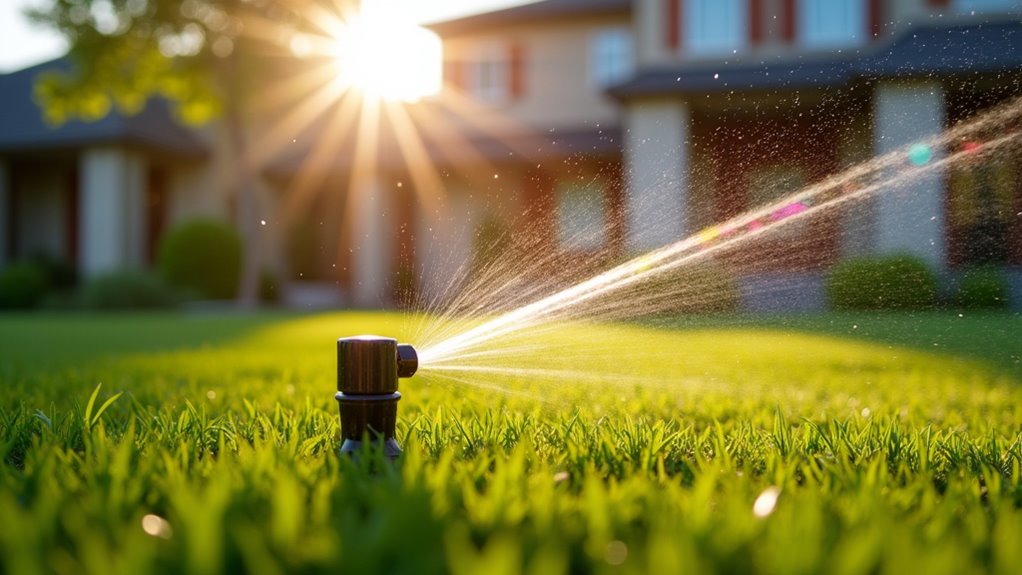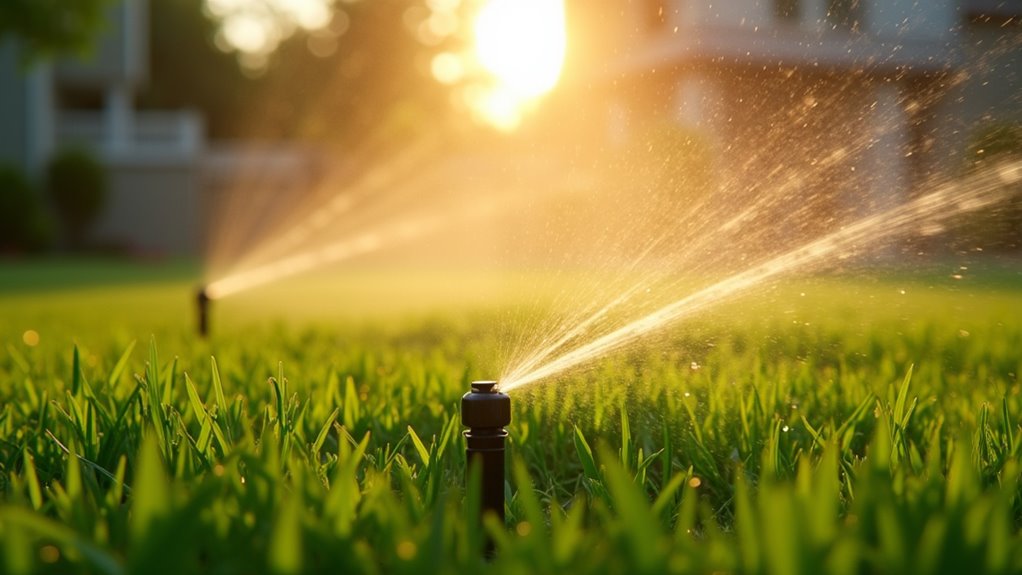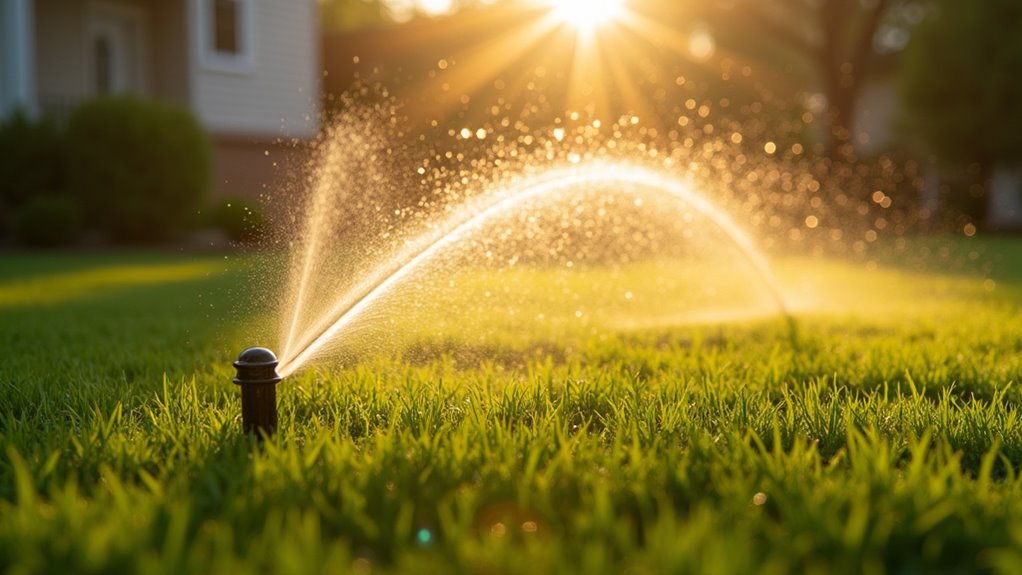To achieve a perfect lawn, you’ll need to master five essential steps: Begin with thorough spring damage inspection and soil testing, equip yourself with quality maintenance tools like sharp mowers and spreaders, implement proper mowing techniques at ideal grass heights, execute strategic fertilization with precise timing, and establish efficient watering practices. Each step builds upon the previous one, creating a systematic approach that transforms your lawn care routine into a science-backed success story.
Spring Inspection and Damage Control
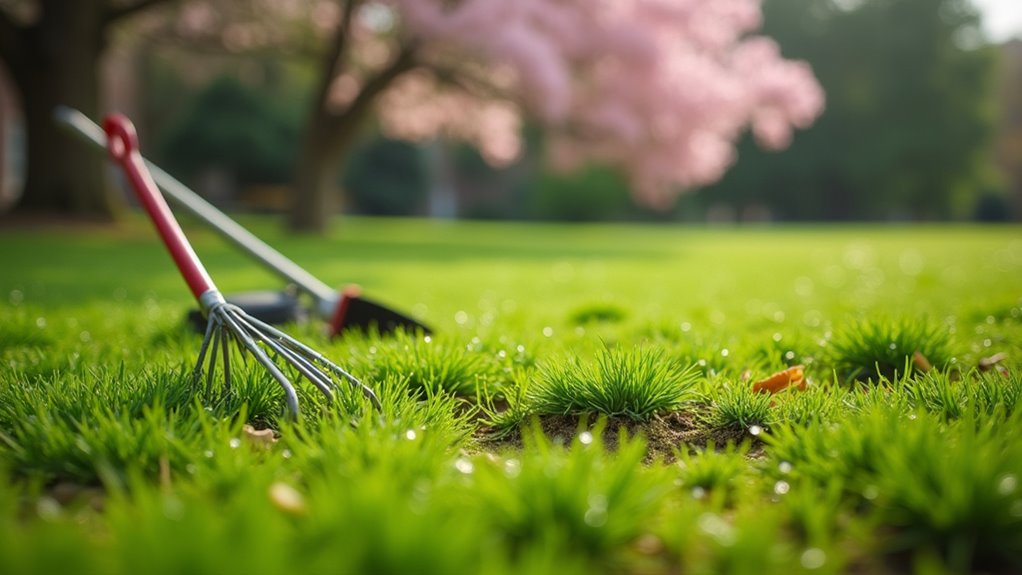
Spring awakening brings essential lawn maintenance tasks to the forefront. Your initial priority is inspecting your spring lawn for snow mold damage, which manifests as matted grass areas with grey or pink discoloration. Pink snow mold poses the most severe threat to dormant grass recovery.
Address compacted soil and improve air circulation by gently raking affected areas where snow mold has developed. Monitor soil temperatures closely, waiting until they consistently reach 55°F before applying pre-emergent crabgrass control, typically in late April. During early spring inspection, identify winter annual weeds and plan your control strategy for late April or early May application. To support healthy root growth and combat nutrient imbalances, apply a balanced 3-1-1 ratio fertilizer. This thorough approach guarantees your lawn moves successfully from winter dormancy to vibrant spring growth.
Essential Lawn Maintenance Equipment
While achieving the perfect lawn demands proper technique and timing, success conclusively depends on having the right equipment at your disposal. Start with a reliable lawn mower featuring sharp mower blades to ensure a clean cut that won’t damage grass roots. You’ll need a quality garden hose and sprinkler system to water the lawn effectively, promoting proper Root Development and lawn density.
Don’t overlook the importance of a dethatching tool to remove dead organic matter between soil and grass blades. A fertilizer spreader is pivotal for even distribution of nutrients based on your soil test results. As you mow your lawn, these tools work together to optimize your mowing habits and manage grass clippings efficiently. Complete your toolkit with essential gardening implements like shovels and pruners for extensive maintenance.
Proper Mowing Techniques and Height Management

Maintaining proper mowing height stands as one of the most critical factors in achieving a healthy, vibrant lawn. Set your mower to cut at 2.5-4 inches for cool-season grasses and 1-3.75 inches for warm-season grass varieties. You’ll want to cut no more than 1/3 of the blade height in a single session to prevent stressing your turf.
Keep mower blades sharp to guarantee clean cuts that minimize water loss and promote faster recovery. Mow in different directions each time you cut to create attractive striped patterns while encouraging stronger lateral growth. Don’t bag those grass clippings – instead, welcome Grasscycle by letting them decompose naturally on your lawn. This practice returns valuable nutrients to the soil and improves its organic matter content, resulting in a more sustainable and healthier lawn.
Strategic Fertilization and Weed Prevention
A successful fertilization and weed control strategy begins with understanding your lawn’s unique nutrient requirements through thorough soil testing. You’ll need to analyze your soil’s pH levels to optimize nutrient uptake and determine if lime or sulfur applications are necessary for your grass type.
Time your pre-emergent weed control precisely when soil temperatures reach 55°F in Spring to prevent crabgrass germination. Apply a balanced 3-1-1 slow-release fertilizer to provide steady nutrients that encourage deep root development. For existing broadleaf weeds like chickweed and bittercress, implement targeted control measures in late April or early May.
Complement your lawn care efforts by maintaining proper mowing heights at 2.5-3 inches. This height helps your grass develop strong roots while naturally suppressing weed growth through increased shade and competition for water and nutrients.
Water Management and Conservation Methods
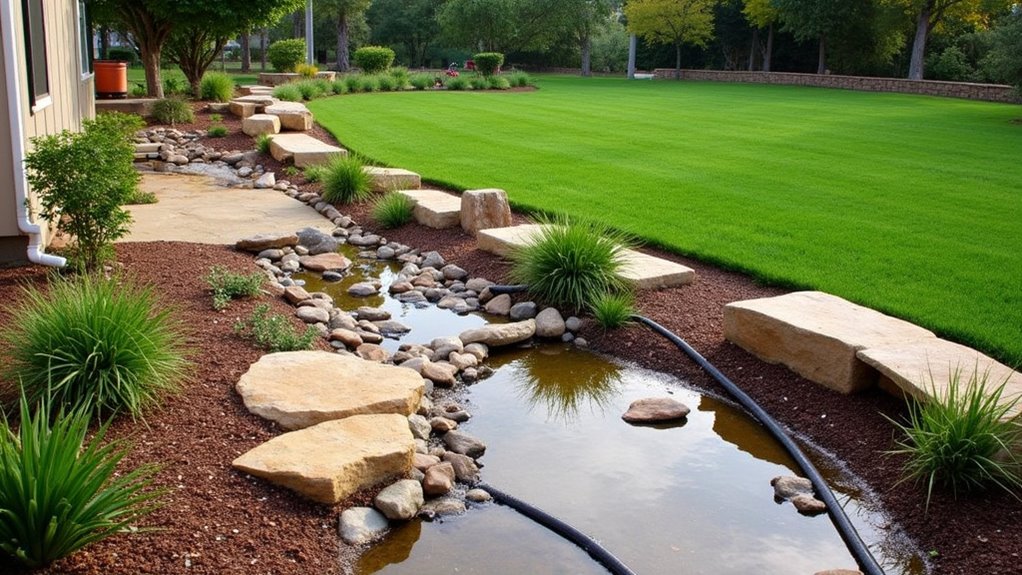
Smart water management naturally complements your fertilization strategy while promoting sustainable lawn health. To maintain a green lawn throughout the growing season, you’ll want to water deeply but infrequently, applying 1-1.5 inches 2-3 times weekly. This good rule of thumb encourages healthy root development, especially during warmer weather.
Make sure you’re using the right tools for efficient irrigation drip systems or soaker hoses are excellent choices. Early morning watering is best, reducing both evaporation and disease risk. Healthy grass needs flexible care, so adjust your watering schedule based on seasonal rainfall. To enhance moisture retention, let grass clippings remain on your lawn after mowing. Consider drought-resistant grass varieties to maintain a beautiful yard while conserving water – they’ll require less maintenance while staying vibrant during dry spells.
Frequently Asked Questions
What Are the Five Steps for Lawn Care?
You’ll need to follow these five essential steps for ideal lawn care: Start with proper soil preparation and apply pre-emergent crabgrass control when soil reaches 55°F. Next, establish a consistent watering schedule and implement weed control measures in late spring. Third, maintain proper mowing frequency at 2.5-3 inches height. Fourth, apply balanced fertilizer following a 3-1-1 ratio. Ultimately, regularly inspect for damage and address issues like snow mold through seasonal maintenance.
What Are the Steps to a Perfect Lawn?
To achieve a perfect lawn, you’ll need to understand your grass type and match it with proper soil conditions. Start by testing soil quality and adjust pH levels accordingly. Maintain consistent mowing frequency at proper heights, and establish a smart irrigation schedule. You’ll want to apply fertilizer seasonally, implement weed control measures, and perform annual aeration. Don’t forget regular edging for clean borders, and overseed when needed to maintain thick, healthy turf coverage.
In What Order Should You Do Your Lawn?
You’ll want to start with soil testing to understand your lawn’s needs. Next, plan your irrigation system installation for proper water management. Follow with aeration schedule and overseeding practices in problem areas. Then implement your weed control methods and fertilizer application timing. Establish proper mowing height adjustments and a consistent mowing schedule. Ultimately, focus on lawn edging options to create clean borders. This sequence guarantees each step builds upon the last for best results.
What Is the Most Common Mistake Seen When Treating Lawns?
The most common mistake you’ll encounter is improper fertilizer application, where you either over-apply or use the wrong type for your grass. You’re also likely making errors with incorrect mowing height and overwatering issues. Don’t forget that neglecting weed control and soil compaction problems can quickly deteriorate your lawn’s health. If you’re experiencing poor drainage conditions or unbalanced pH levels, you’ll need to address these issues through proper aeration and regular soil testing.

